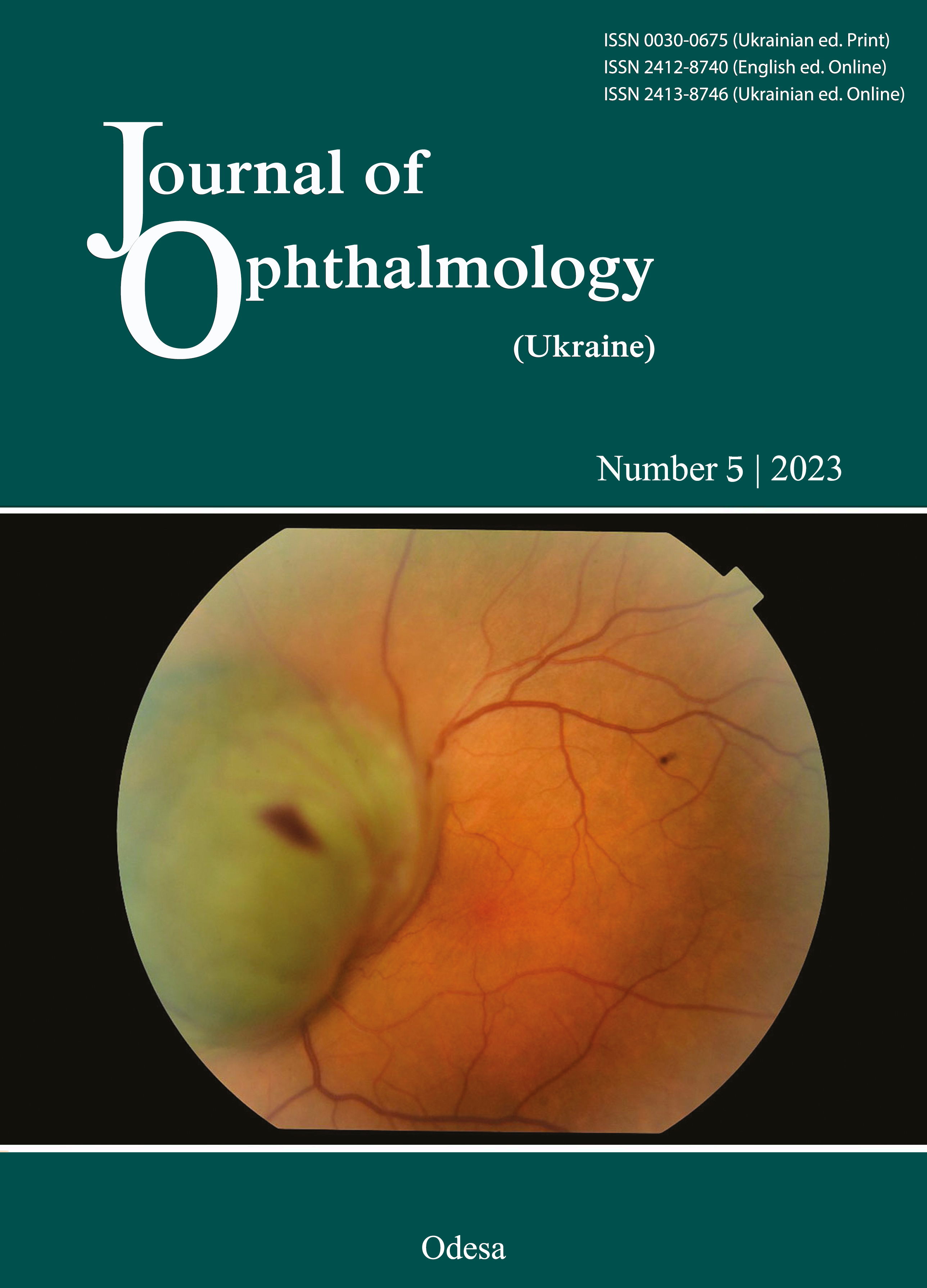Preoperative visual function characteristics having an effect on the success of exotropia surgery
DOI:
https://doi.org/10.31288/oftalmolzh202351621Keywords:
exotropia, surgical treatment, stereopsis, near point of convergenceAbstract
Background: There are individual reports on the effect of some preoperative characteristics of visual functions (like convergence, angle of deviation, presence of fusion and type of binocular vision) on the success of exotropia surgery. To date, however, it has not been established what are the major diagnosis-related prognostic factors for the success of surgery for exotropia.
Purpose: To identify the preoperative characteristics of visual functions which have an effect on the success of surgery for exotropia.
Material and Methods: Of the 59 exotropes (age range, 10 to 21 years) included in this study, 33 had basic constant exotropia (group 1) and 26, intermittent exotropia (group 2). Patients underwent an ophthalmological and ortoptic examination of the motor and sensory systems of the eye. Patients with surgery success (postoperative orthotropes) were compared to those who had a residual exotropia of more than 10 prism diopters (PD) postoperatively in terms of the preoperative accommodative convergence–accommodation (AC/A) ratio, near point of convergence (NPC), distance stereopsis and near stereoacuity threshold.
Results: Our analysis of the preoperative NPC, AC/A ratio and stereopsis for the group with postoperative orthotropic alignment and the group with postoperative exotropic alignment found preoperative close to normal values of AC/A ratio (4.0 ± 1.65 PD/D), NPC (8.03 ± 3.02 cm), the presence of distance stereopsis and near stereopsis (passing the 200 second of arc image on the Lang II stereo card) and the absence of medial rectus hypofunction of hyperfunction in 83.05% of patients of the former group.
Conclusion: Preoperative close to normal values of AC/A ratio (4.0 ± 1.65 PD/D), NPC (8.03 ± 3.02 cm), the presence of distance stereopsis and near stereopsis (passing the 200 second of arc image on the Lang II stereo card) and the absence of medial rectus hypofunction of hyperfunction can be the factors favoring the success of exotropia surgery.
References
Von Noorden GK, Campos E. Binocular Vision and Ocular motility. Theory and Management of Strabismus. 6th ed. St Louis: Mosby; 2002.
Duane A. Binocular Vision and projection. Arch Ophthalmology. 1931; 5: 734-753. https://doi.org/10.1001/archopht.1931.00820050056005
Duane A. Diplopia and other disorders of binocular projection. Arch Ophthalmology. 1932; 7: 187-210. https://doi.org/10.1001/archopht.1932.00820090027003
Chavasse F. Worth's squint: or the binocular reflexes and the treatment of strabismus. 7th ed. London: Bailliére, Tindall and Cox; 1939.
Kashchenko TP, Pospelov VI, Shapovalov SL. [Problems of oculomotor and binocular pathology]. In: Proceedings of the 8th Congress of Ophthalmologists of Russia; June 1-4, 2015; Moscow, Russia. Moscow: MNTK "Eye Microsurgery" Publishing Center; 2015. p. 740-1. Russian.
Burian HM. Exodeviations: their classification, diagnosis and treatment. Am J Ophthalmol. 1966 Dec;62(6):1161-6. https://doi.org/10.1016/0002-9394(66)92570-0
Demer JL, Clark RA, Miller JM. Heterotropy of extraocular muscle pulleys causes incomitant strabismus. In: Lennardstand G, editor: Advances in strabismus. Proceedings of the 8th meeting of ISA Maastrcht, September 10-12, 1991. Buren, the Netherlands: Aeolus Press; 1999. p. 91-4.
Jampolsky A. Ocular divergence mechanisms. Trans A Ophthalmol Soc. 1970; 68: 730-822.
Dzelkaleia IIa. [Clinical characteristics of divergent concomitant strabismus]. Oftalmol Zh. 1985; 7:437-9. Russian.
Hatt SR, Leske DA, Liebermann L, et al. Quantifying variability in the measurement of control in intermittent exotropia. J AAPOS. 2015; 19:33-7.
https://doi.org/10.1016/j.jaapos.2014.10.017
Boichuk IM, Alui Tarak. Stereopsis before and after surgical treatment for constant versus intermittent exotropia. J Оphthalmol. (Ukraine). 2021; 3:23-7. https://doi.org/10.31288/oftalmolzh202132327
Beneish R, Flanders M. The role of stereopsis and early postoperative alignment in long-term results of intermittent exotropia. Can J Ophthalmol. 1994;29:119-124.
Wang L, Zhao K. Hot topics in treatment of intermittent exotropia. Zhonghua Yan Ke Za Zhi. 2015 Jun;51(6):465-9. Chinese.
Thorisdottir RL, Malmsjö M, Tenland K, et al. The Success of Unilateral Surgery for Constant and Intermittent Exotropia and Factors Affecting It in a Large Scandinavian Case Series. J Pediatric Ophthalmol Strabismus. 2021 Jan 1;58:34-41. https://doi.org/10.3928/01913913-20201007-04
Jung EH, Kim SJ, Yu YS. Factors associated with surgical success in adult patients with exotropia. J AAPOS. 2016 Dec 1;20(6):511-4. https://doi.org/10.1016/j.jaapos.2016.08.011
Whrite KW, editor. Color Atlas of Ophthalmic Surgery: Strabismus. Philadelphia: Lippincott; 1991.
Avetisov ES. Concomitant strabismus. Moscow: Meditsina; 1977. Russian.
Reading RW. Binocular vision: foundations and applications. Boston: Butterworth;1983. https://doi.org/10.1097/00006324-198310000-00011
Kim MK, Kim US, Cho MJ, et al. Hyperopic refractive errors as a prognostic factor in intermittent exotropia surgery. Eye (Lond). 2015; 29: 1555-1560. https://doi.org/10.1038/eye.2015.152
Lee DS, Kim S-J, Yu YS. Preoperative and postoperative near stereoacuities and surgical outcomes in intermittent exotropia. Br J Ophthalmol. 2014; 98: 1398-1403. https://doi.org/10.1136/bjophthalmol-2013-304853
Mohan K, Sharma SK. Comparison of Long-term Stereoacuity Improvement Between Patients With Initial Subnormal Stereopsis and Nil Stereopsis in Refractive Accommodative Esotropia. J Pediatric Ophthalmol Strabismus. 2022 Jan 1:1-6. https://doi.org/10.3928/01913913-20211115-02
Huh J, Ha SG, Kim SH. Huh J, Ha SG, Kim SH. Recovery from suppression with successful motor alignment after surgery for intermittent exotropia. J Pediatric Ophthalmol Strabismus. 2020; 57: 21-6. https://doi.org/10.3928/01913913-20191016-03
Birch EE, Gwiazda J, Held R. The development of vergence does not account for the onset of stereopsis. Perception. 1983;12:331-6. https://doi.org/10.1068/p120331
Wu Y, Xu M, Zhang J, et al. Can Clinical Measures of Postoperative Binocular Function Predict the Long-Term Stability of Postoperative Alignment in Intermittent Exotropia? J Ophthalmol. 2020; 2020:7392165. https://doi.org/10.1155/2020/7392165
Awaya S, Nozaki H, Itoh T, et al. Studies of suppression in alternating constant exotropia and intermittent exotropia with reference to fusional background. In: Moore S, Mein J, Stockbridge L, editors. Orthoptics: Past, Present, Future. Transactions of the Third International Orthoptics Congress; July 1-3, 1975; Boston, the USA.
Awaya S, Sugawara M, Komiyama K, et al. [Studies on stereoacuity in four constant exotropes with good stereoacuity--with a special reference to the Titmus Stereo Test and EOG analysis]. Nippon Ganka Gakkai Zasschi. 1979;83: 425-30. Japanese.
Na KH, Kim SH. Comparison of clinical features and long-term surgical outcomes in infantile constant and intermittent exotropia. J Pediatric Ophthalmol Strabismus. 2016; 53: 99-104. doi: 10.3928/01913913-20160122-05. https://doi.org/10.3928/01913913-20160122-05
Zou D, Casafina C, Whiteman A, et al. Predictors of surgical success in patients with intermittent exotropia. J AAPOS. 2017 Feb 1; 21: 15-8. https://doi.org/10.1016/j.jaapos.2016.11.018
Downloads
Published
How to Cite
Issue
Section
License
Copyright (c) 2023 Boichuk I. M., Tarak Alui

This work is licensed under a Creative Commons Attribution 4.0 International License.
This work is licensed under a Creative Commons Attribution 4.0 International (CC BY 4.0) that allows users to read, download, copy, distribute, print, search, or link to the full texts of the articles, or use them for any other lawful purpose, without asking prior permission from the publisher or the author as long as they cite the source.
COPYRIGHT NOTICE
Authors who publish in this journal agree to the following terms:
- Authors hold copyright immediately after publication of their works and retain publishing rights without any restrictions.
- The copyright commencement date complies the publication date of the issue, where the article is included in.
DEPOSIT POLICY
- Authors are permitted and encouraged to post their work online (e.g., in institutional repositories or on their website) during the editorial process, as it can lead to productive exchanges, as well as earlier and greater citation of published work.
- Authors are able to enter into separate, additional contractual arrangements for the non-exclusive distribution of the journal's published version of the work with an acknowledgement of its initial publication in this journal.
- Post-print (post-refereeing manuscript version) and publisher's PDF-version self-archiving is allowed.
- Archiving the pre-print (pre-refereeing manuscript version) not allowed.












